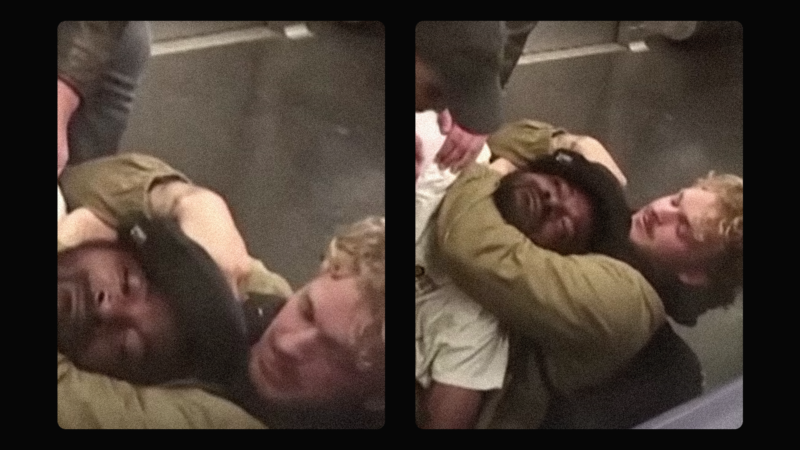Jordan Neely Wasn't Killed by the System
Opposing sides of the debate around a New York City subway homicide have found unlikely common ground.

News that a mentally ill man had been killed last week on a New York City subway and the conversation that followed almost immediately became a synecdoche for the wider social debate about rising crime, public disorder, racial divides, and attitudes towards the homeless population. But whether they realize it or not, those on opposite ends of that discussion seem to agree on a core point: It was, in some sense, the fault of "the system" that Jordan Neely was choked to death on the F train.
"Had he been in treatment, Jordan Neely's death in a subway car may have been prevented," wrote Manhattan Institute Senior Fellow Stephen Eide in City Journal. The City Journal has devoted a great deal of energy to arguing that recent upticks in urban disorder suggest a need for a more punitive or carceral approach. On this account, if Neely hadn't been out and about—because he either was in jail or perhaps involuntarily in a mental health institution—he wouldn't have died.
But that line of thinking often fails to account for the fact that Neely was engaged with the criminal justice system repeatedly throughout the course of his life. He was released from Rikers Island, the notorious New York City jail, in February of this year, reportedly after spending 15 months behind bars. It is true that Neely would not have been available to be killed on the subway last week had he been indefinitely locked away, but we don't lock people up in order to protect them from being choked.
Eide, refreshingly, is aware of these limitations. "Criminal-justice reformers might point out, correctly, that Neely's many past arrests did not stabilize him," he noted. "But nor did whatever contact he may have had with homeless outreach teams, social workers, safe-haven shelters, and outpatient clinics." This is also true, though I'd argue it hints at the fact that the system cannot prevent every harm, no matter how many resources society grants it.
The inverse conclusion is more popular, though, and it traverses typical tribal lines. "We should demand a full accounting from all of these [New York City] officials," says Errol Louis in New York magazine. "Neely, it seems, had encountered many of the clinics, hospitals, and social-service organizations we collectively (and optimistically) call a social safety net, including the Bowery Residents' Committee and Bellevue Hospital." Though Louis doesn't label the carceral system as the perpetrator, he arrives at a similar judgment: The government could have saved Neely, given the chance.
That this is a dubious claim should be apparent from Louis' own accounting of the tragedy. Public and private actors alike sought to intervene in Neely's life for years. He had worked with an Intensive Mobile Treatment team composed of mental health street counselors who provide services to homeless people. The Bowery Residents' Committee, which specifically works in subways, had been in touch with Neely since 2017. He had been in and out of Bellevue Hospital for several years. Outreach workers interacted with him multiple times in the months leading up to his killing.
New York is a city of over 8 million people, many of whom struggle with mental health issues. About one in every 120 New Yorkers is homeless, according to the Bowery Mission, which translates to about 70,000 people. No government, even with the most robust and muscular of programs, will be able to save every resident suffering from poor mental health, a lack of housing, or both, as the two often go hand in hand.
"I don't have food. I don't have a drink, I'm fed up," Neely yelled, according to Juan Alberto Vazquez, a freelance journalist who captured Daniel Penny holding him in a chokehold for several minutes. Neely reportedly suffered from schizophrenia and depression, with his mental health deteriorating after his mother was murdered and her body stuffed in a suitcase when he was 14 years old. "I don't mind going to jail and getting life in prison. I'm ready to die," he said.
He died shortly thereafter. People will argue about how reasonable it was for Penny to initially restrain Neely. But "the system" was not on the subway with him that day. Daniel Penny was, though, and he allegedly choked Neely for 15 minutes. Vazquez's video, which caught a portion of that interaction, shows Neely writhing, attempting to clutch up at a subway seat, one leg slowly kicking. Eventually, another passenger can be heard telling Penny that he was "gonna catch a murder charge."
"My wife is ex-military," the passenger said. "You're gonna kill him now."
Penny maintains he did nothing wrong. "Mr. Neely had a documented history of violent and erratic behavior, the apparent result of ongoing and untreated mental illness," his attorneys said in a statement. "For too long, those suffering with mental illness have been treated with indifference."
It's in this vein that Penny finds unlikely common ground with writers like Louis. "Jordan Neely was already dead," he wrote in his New York piece, metaphorically put to death by government negligence.
Inconvenient to that claim is that the government was deeply involved in trying to help Neely. And he wasn't, in fact, dead. Until a man killed him—something no complaint about the system can explain away.

Show Comments (144)